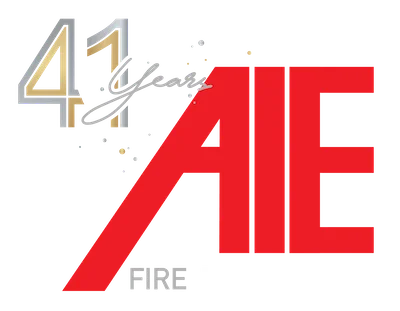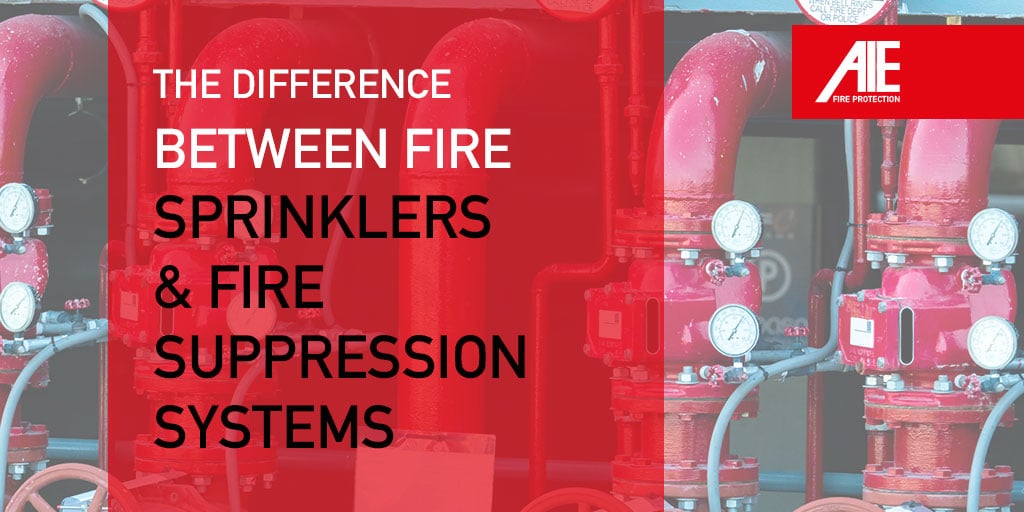Fire sprinklers and fire suppression systems ultimately serve the same purpose – to extinguish fire as quickly as possible, saving lives and property. The difference between commercial sprinkler systems and fire suppression systems is in the each extinguishes fires for multi-site facilities, big-box stores and retail chains, grocery stores, wholesale clubs, restaurants, distribution centers, and other commercial buildings. You must understand the different commercial fire protection systems and types of fire sprinkler systems.
Fire sprinklers use water to extinguish and control fires while commercial fire suppression systems use a variety of non-water-based agents; both systems are commonly used together in different areas of a building, depending on contents and hazards. In this article you will learn:
- When fire sprinkler systems are the best
- Types of fire sprinklers
- When to use non-water fire suppression systems
- Types of fire suppression systems: wet v. dry
Fire Systems Comparison: Find the Best System for Your Business Needs
To help determine which is the best fire protection sprinkler system for each area of your business, AIE has compiled some basic information to help you compare fire safety systems.
Then, when you’re ready to decide on a new or retrofitted fire protection system, consult with experienced fire safety professionals before making any final equipment purchases.


Where Commercial Sprinkler Systems are the Best Solution
Sprinkler systems are the most common commercial fire protection systems because they extinguish fires rapidly and effectively by discharging water when heat is detected. These are commonly used in national multi-site retail chains, big-box stores, wholesale clubs, grocers, restaurants, and distribution centers. Commercial sprinkler systems are safe to use and offer versatility and compatibility within a variety of applications.
Types of Commercial Fire Sprinkler Systems
Wet-Pipe Sprinkler Systems
Pipes hold water constantly and heads are ready to spray at any time; most universal.
Dry Powder Sprinkler Systems
Pipes fill with water when system is activated; best for unheated or vacant buildings.
Deluge Fire Sprinkler Systems
Sprinkler heads are always open, pipes fill with water when activated; used in high-hazard areas such as power plants and chemical storage.
Pre-Action Sprinkler Systems
Require activation of supplemental fire detection system first; helps avoid accidental discharge in places with irreplaceable or expensive items.
– NFPA Report, U.S. Experience with Sprinklers, 2010-2014
Where Fire Sprinklers May Not Be the Best Option
Though commercial fire sprinkler systems are the preferred fire protection solution for many types of retail chains, multi-site retailers, big box stores, distribution warehouses, and restaurants across the country, there are places where fire sprinklers are not the best option.
If the water will either not put the fire out (kitchens, flammable liquid areas) or may cause irreparable damage to the contents or building itself (computer rooms, file storage, archives, equipment rooms) sprinklers will not suit your needs. These building applications call for a non-water-based fire suppression system.

What is a Commercial Fire Suppression System?
Similar in style, function, and purpose of fire sprinklers, fire suppression systems “suffocate” the fire with chemical, gaseous, or foam agents, rather than water. Since dry fire suppression systems do not use water, they typically cause minimal damage to valuable assets and will stop extremely hot, chemical-based or grease fires quickly.
How Do I Know if I Need a Fire Suppression System?
So, how do you know if your multi-site facilities will need a suppression system, fire sprinkler system, or both? Ask yourself these questions:
- Is there valuable equipment that would be damaged by water?
- Are flammables/combustibles used/stored in the facility or on store shelves?
- Is there a dedicated computer room, equipment room, or an area with unique assets?
- What about archived paperwork, documents, or irreplaceable items that would be ruined by water?
If you answered yes to any of these, most likely each location will need one or more of the following suppression systems in those areas.
Different Types of Fire Suppression Systems & Where They Are Used Most
FM 200 Fire Suppression System – the most common of type of suppression systems for all multi-site, large-scale companies, the FM 200 releases a safe chemical gas that inhibits the chemical reaction of the combustible materials and oxygen. It is the fastest system (reaches extinguishing levels in 10 seconds or less), requires no cleanup, leaves no residue. Safe for people, flammable liquids/combustibles, and electronics.
Wet Chemical Suppression System – discharges a vaporous liquid over a burning surface that quickly reacts with fats and oils to produce a foam that cools the surface, extinguishes the fire, and prevents re-ignition. Ideal for restaurant and other commercial kitchens. Safe for people, flammable liquids/combustibles.
Dry Fire Suppression Systems – releases a dry chemical powder (much like an ABC fire extinguisher) onto the fire when activated. Safe for people, flammable liquids/combustibles, and electronics.
Carbon Dioxide (CO2) Suppression System – works by displacing/taking away the oxygen that fire needs to survive. It is also very cold, which cools the fire. It is colorless and odorless. Not safe for people, but regularly used for engine/generator rooms, flammable liquid storage rooms, power stations, large industrial machines.

The Best? Commercial Sprinkler System vs. Fire Suppression Systems
Now that you’re aware of the differences between fire protection systems and how they work to stop fire in different areas of the building, you can think about which options would be best in a new facility or if you’re retrofitting a system in an existing building.
And, of course, before you make any final decisions, it’s imperative that you contact your local Authorities Having Jurisdiction (AHJ) to learn local codes, and follow those of the National Fire Protection Association, such as NFPA25, NFPA17, NFPA 2001, and other fire system management requirements for your facility.
Work with Companies Experienced in Sprinkler Fire Protection
Once you have contacted your AHJ, that’s a great time to reach out to AIE, a national fire protection company that can support multiple locations across the region or nation during all phases of fire system design, engineering, construction, code consulting and inspections; compliance, maintenance, repairs, and water supply services. We can help you determine the best fire protection sprinkler system for you.
Our coast-to-coast, full-service fire protection solutions provide retail chains, grocery stores and big-box stores; industrial, distribution, manufacturing, and many other multi-site management facilities with reliable, code-compliant systems, measurable value, and streamlined fire safety, 365 days a year. We know the types of fire sprinkler systems and what is best for your business. Contact us today to learn how our experienced team can optimize your fire protection. 800-892-9863
Information posted in our blog is merely for educational and informational purposes. While the information has been verified to the best of our abilities, we cannot guarantee its total accuracy, and it should not be considered legally binding advice. This blog is not intended as a substitute for professional advice, and should you decide to act upon the information, you do so at your own risk.


Recent Comments